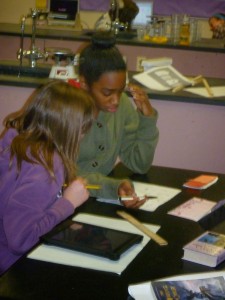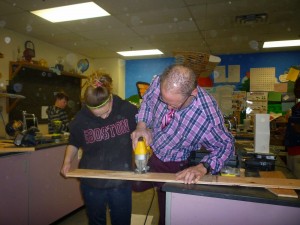There are always opportunities for learning life skills at the Kurn Hattin Homes (Westminster, VT) Tech Wizards site. Mr. Fontaine’s science classes recently executed an extensive ornithology project from start to finish, developing new life skills along the way.
In the first stage of the project, using their iPads, the student citizen scientists learned that habitat loss is the single greatest threat to native
bird populations. They learned that they could offset this threat by creating habitats in their backyard and decided to make the Kurn Hattin campus their laboratory.
Their research led them to many resources on the Internet, but the most helpful information came from the Cornell Lab of Ornithology, a unit of Cornell University in Ithaca, New York which studies birds and other wildlife (the Lab’s BirdSleuth curriculum is designed to help elementary and middle-school students discover science through bird projects) and from the National Audubon Society.
 Asking the question, “What do birds want in a house?” the Tech Wizards identified birdhouse designs that they would like to build. Incorporated into their designs were location (5 feet or more off the ground, atop a pole or post, or attached to a tree trunk, with an east-facing entry away from prevailing winds), creating a cozy space (5 by 5 inches at the bottom is an ideal dimension for most species with an overall height of 10 to 12 inches), the right-size entry (different size holes attract different kinds of birds), a slanted roof (allowing rainwater to run off easily), and sources of desired nesting materials (most songbirds will reuse the house the following year but won’t reuse a nest which means they need new stuff each spring such as moss, twigs, feathers, pine needles, shredded bark, soft grasses, yarn scraps, small pieces of fabric and hair (human, dog or horse).
Asking the question, “What do birds want in a house?” the Tech Wizards identified birdhouse designs that they would like to build. Incorporated into their designs were location (5 feet or more off the ground, atop a pole or post, or attached to a tree trunk, with an east-facing entry away from prevailing winds), creating a cozy space (5 by 5 inches at the bottom is an ideal dimension for most species with an overall height of 10 to 12 inches), the right-size entry (different size holes attract different kinds of birds), a slanted roof (allowing rainwater to run off easily), and sources of desired nesting materials (most songbirds will reuse the house the following year but won’t reuse a nest which means they need new stuff each spring such as moss, twigs, feathers, pine needles, shredded bark, soft grasses, yarn scraps, small pieces of fabric and hair (human, dog or horse).
After designing came the building. Then they measured and projected to scale, put together plans, and built paper birdhouses. When they had their new design skills down, they planned and made wooden birdhouses. As an experiment, some were painted with non-toxic colors to see if they attracted birds differently. Once their wooden birdhouses were hung in the trees on campus, the children began repairing the School farm’s existing birdhouses.
The next project planned for these Tech Wizards will be an extension of this activity. Taking the skills that they have learned building birdhouses to the next level, they will become architects, engineers, builders, and financial planners as they build model homes. Each Tech Wizard will be given a budgeted amount of money, and will use their drafting skills to plan and build a miniature home to scale. They will keep a ledger with a checkbook, and write checks for materials and contractors in the process of planning and building their home. In this way, the Tech Wizard’s experiential-learning approach to science engages the youth in activities that allow them to experiment, reflect upon what happened, and apply what they have learned. As their homes are being constructed, they will keep journals, reflecting on their successes and likely “do-overs” and discuss how their efforts relate to their everyday lives and are instrumental in achieving the goals they have made for themselves.




Recent Comments